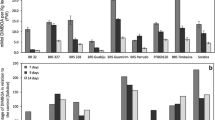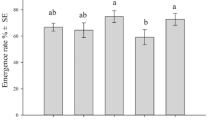Abstract
DIMBOA (2,4-dihydroxy-7-methoxy-1,4-benzoxazin-3-one), a secondary metabolite found in cereal extracts, confers resistance in wheat to aphids. Its effect on beneficial organisms was tested on larvae of the aphid predatorEriopis connexa Germar. Larvae were fed until pupation on artificial diets to which different concentrations of DIMBOA (2–200μg/g diet) were added, as well as on aphids that had been feeding on wheat seedlings with different DIMBOA levels (140–440 μg/g fresh tissue). In diets, the effect of DIMBOA was greatest on survival of third-instar larvae and on the duration of the second and fourth instars. When aphids were provided as food, those that had fed on a wheat cultivar with an intermediate DIMBOA level led to a significantly longer larval duration in the predator than did those that fed on either low or high DIMBOA cultivars. Shortest predator development times were obtained with aphid prey that had fed on high DIMBOA seedlings. Higher DIMBOA levels in the plant appear to reduce aphid feeding rates (and rates of DIMBOA ingestion), decreasing aphid survival and minimizing the effect of the toxin on the predator.
Similar content being viewed by others
References
Argandonã, V.H., Luza, J.G., Niemeyer, H.M., andCorcuera, L.J. 1980. Role of hydroxamic acids in the resistance of cereals to aphids.Phytochemistry 19:1665–1668.
Argandoña, V.H., Niemeyer, H.M., andCorcuera, L.J. 1981. Effect of content and distribution of hydroxamic acids in wheat on infestation by the aphidSchizaphis graminum.Phytochemistry 20:673–676.
Argandoña, V.H., Corcuera, L.J., Niemeyer, H.M., andCampbell, B.C. 1983. Toxicity and feeding deterrency of hydroxamic acids from Gramineae in synthetic diets against the greenbug,Schizaphis graminum.Entomol. Exp. Appl. 34:134–138.
Atallah, Y.H., andNewson, L.D. 1966. Ecological and nutritional studies onColeomegilla maculata De Geer (Coleoptera: Coccinellidae). I. The development of an artificial diet and a laboratory rearing technique.J. Econ. Entomol. 59:1173–1179.
Barbosa, P., Saunders, J.A., Kemper, J., Trumbule, R., Olechno, J., andMartinat, P. 1986. Plant allelochemicals and insect parasitoids. Effect of nicotine onCotesia congregata (Say.) (Hymenoptera: Braconidae) andHyposoter annulipes (Cresson) (Hymenoptera: Ichneumonidae).J. Chem. Ecol. 12:1319–1328.
Bergman, J.M., andTingey, W.M. 1979. Aspects of the interaction between plant genotypes and biological control.Bull. Entomol. Soc. Am. 25:275–279.
Bohidar, K., Wratten, S.D., andNiemeyer, H.M. 1986. Effects of hydroxamic acids on the resistance of wheat to the aphidSitobion avenae.Ann. Appl. Biol. 109:193–198.
Campbell, B.C., andDuffey, S.S. 1979. Tomatine and parasitic wasps: potential incompatibility of plant antibiosis with biological control.Science 205:700–702.
Campos, F., Atkinson, J., Arnason, J.T., Philogene, B.J.R., Morand, P., Werstiuk, N.H., andTimmins, G. 1989. Toxicokinetics of 2,4-dihydroxy-7-methoxy-1,4-benzoxazin-3-one (DIMBOA) in the European corn borer,Ostrinia nubilalis (Hübner).J. Chem. Ecol. 15:1989–2001.
Copaja, S.V., Barria, B.N., andNiemeyer, H.M. 1991a. Hydroxamic acid content of perennial Triticeae.Phytochemistry 30:1531–1534.
Copaja, S.V., Niemeyer, H.M., andWratten, S.D. 1991b. Hydroxamic acid levels in Chilean and British wheats.Ann. Appl. Biol. 118:223–237.
Emden, H.F. van, andWratten, S.D. 1991. Tri-trophic level interactions between host plants, aphids and predators, pp. 29–43,in D.C. Peters, J.A. Webster, and C.S. Chlouber (eds.). Aphid-Plant Interactions: Populations to Molecules. Report MP-132 Oklahoma Agricultural Experimental Station.
Ferran, A., andLaforge, J.P. 1975. L'alimentation artificielle des larves de la coccinelle aphidophageAdonia 11-notata Sch. (Col.: Coccinellidae).Ann. Zool. Ecol. Anim. 7:1–12.
Givovich, A., andNiemeyer, H.M. 1991. Hydroxamic acids affecting barley yellow dwarf virus transmission by the aphidRhopalosiphum padi.Entomol. Exp. Appl. 59:79–85.
Givovich, A.,Morse, S.,Cerda, H.,Niemeyer, H.M.,Wratten, S.D., andEdwards, P.J. 1992. Hydroxamic acid glucosides in the honeydew of aphids feeding on wheat.J. Chem. Ecol. Submitted.
Herrera, A.J. 1960. Investigaciones sobre la cria artificial del coccinélidoColeomegilla maculata (De Geer).Rev. Per. Entomol. Agric. 3:1–6.
Herrera, G., andQuiroz, C.E. 1988. Yield losses in wheat caused by natural infection of BYDV, in trials maintained during 10 seasons, from 1976 to 1985. Santiago, Chile.Agric. Téc. (Chile) 48:75–80.
Macfarlane, R.P. 1985. A Kiwi on tour to Chile, England and France.Weta 8:18–22.
Niemeyer, H.M. 1988a. Hydroxamic acids (4-hydroxy-1,4-benzoxazin-3-ones), defence chemicals of the Gramineae.Phytochemistry 27:3349–3358.
Niemeyer, H.M. 1988b. Hydroxamic acid content ofTriticum species.Euphytica 37:289–293.
Niemeyer, H.M., Bravo, H.R., Pena, G.F., andCorcuera, L.J. 1982. Decomposition of 2,4-dihydroxy-7-methoxy-2H-1,4-benzoxazin-3-(4H)-one, a hydroxamic acid from Gramineae, pp. 22–28,in H. Kehl (ed.). Chemistry and Biology of Hydroxamic Acids, Karger AG, Basel.
Niemeyer, H.M., Pesel, E., Copaja, S.V., Bravo, H.R., Franke, S., andFrancke, W. 1989a. Changes in hydroxamic acid levels of wheat plants induced by aphid feeding.Phytochemistry 28:447–449.
Niemeyer, H.M., Pesel, E., Franke, S., andFrancke, W. 1989b. Ingestion of the benzoxazinone DIMBOA from wheat plants by aphids.Phytochemistry 28:2307–2310.
Queirolo, C.B., Andreo, C.S., Niemeyer, H.M., andCorcuera, L.J. 1983. Inhibition of APTase from chloroplasts by a hydroxamic acid from Gramineae.Phytochemistry 22:2455–2458.
Ramírez, I.A. 1990. A review of barley yellow dwarf in the Southern cone countries of South America, pp. 362–367,in P.A. Burnett (ed.). World Perspectives on Barley Yellow Dwarf. CIMMYT, Mexico, D.F., Mexico.
Starks, K.J., Muniappan, R., andEikenbary, R.D. 1972. Interactions between plant resistance and parasitism against the greenbug on barley and sorghum.Ann. Entomol. Soc. Am. 65:650–655.
Thackray, D.J., Wratten, S.D., Edwards, P.J., andNiemeyer, H.M. 1990. Resistance to the aphidsSitobion avenae andRhopalosiphum padi in Gramineae in relation to hydroxamic acid levels.Ann. Appl. Biol. 116:573–582.
Thorpe, K.W., andBarbosa, P. 1986. Effects of consumption of high and low nicotine tobacco byManduca sexta (Lepidoptera: Sphingidae) on survival of the gregarious endoparasitoidCotesia congregata (Hymenoptera: Braconidae).J. Chem. Ecol. 6:1329–1337.
Wink, M., andRömer, P. 1986. Acquired toxicity-the advantages of specializing on alkaloidsrich lupins toMacrosiphon albifrons (Aphidae).Naturwissenschaften 73:210–212.
Wratten, S.D.,Martin, J.J.,Rhind, D., andNiemeyer, H.M. 1991. Mechanisms of resistance in cereals to pests, pp. 925–934,in Proceedings of 1990 Brighton Pest Control Conference, Pests and Diseases.
Zadoks, J.C., Chang, T.T., andKonzak, C.F. 1974. A decimal code for the growth stages of cereals.Weed Res. 14:415–421.
Zuñiga, E. 1987. Biological control of cereal aphids in the southern cone of South America, pp. 362–367,in P.A. Burnett (ed.). World Perspectives on Barley Yellow Dwarf. CIMMYT, Mexico, D.F., Mexico.
Author information
Authors and Affiliations
Additional information
On leave from Departamento de Entomologia, Universidad Nacional Agraria La Molina, Apartado aéreo 456, Lima, Perú.
Rights and permissions
About this article
Cite this article
Martos, A., Givovich, A. & Niemeyer, H.M. Effect of DIMBOA, an aphid resistance factor in wheat, on the aphid predatorEriopis connexa Germar (Coleoptera: Coccinellidae). J Chem Ecol 18, 469–479 (1992). https://doi.org/10.1007/BF00994245
Received:
Accepted:
Issue Date:
DOI: https://doi.org/10.1007/BF00994245




